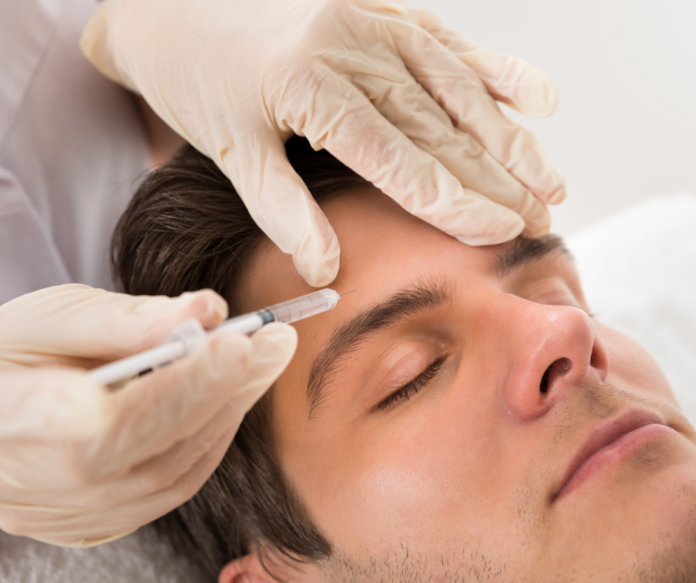
Dermal Fillers for Men: What to Know?
As the popularity of non-surgical cosmetic treatments continues to rise. More men are seeking out medspa services to enhance their appearance and boost their confidence. One such treatment that has gained significant traction among men is dermal fillers. This article aims to address the informational queries regarding dermal fillers for men. Providing specific answers and solutions to help you make an informed decision.
What are Dermal Fillers?
Dermal fillers are injectable substances used to restore volume, smooth out wrinkles, and enhance facial contours. They are made from various materials. With the most common being hyaluronic acid (HA), a naturally occurring substance in the body that helps to maintain skin hydration and elasticity. Other types of fillers include calcium hydroxylapatite, poly-L-lactic acid, and polymethylmethacrylate (PMMA) microspheres. Each type of filler has its unique properties and is suited for different treatment areas and desired outcomes. (source)
Why are Men Opting for Dermal Fillers?
Dermal Fillers for Men: What to Know?
Men are increasingly turning to dermal fillers for various reasons, including:
- Age-related volume loss: As men age, they may experience a loss of facial volume. Leading to sagging skin, hollow cheeks, and deepened nasolabial folds. Dermal fillers can help restore this lost volume, resulting in a more youthful appearance.
- Wrinkle reduction: Fillers can be used to smooth out wrinkles and fine lines. Such as crow’s feet, forehead lines, and marionette lines, giving the face a more refreshed and rejuvenated look.
- Facial contouring: Men may seek dermal fillers to enhance their facial features. Such as creating a more defined jawline, augmenting the chin, or adding volume to the cheeks for a more masculine appearance.
- Non-surgical alternative: Dermal fillers offer a non-invasive alternative to surgical procedures. Such as facelifts or chin implants, with minimal downtime and lower risks.
What to Expect During a Dermal Filler Treatment
Before undergoing a dermal filler treatment, it’s essential to have a consultation with a qualified medical professional to discuss your goals and expectations. They will assess your facial anatomy, skin quality, and medical history. This is to determine the most suitable filler type and treatment plan for you.
The treatment itself typically takes 30 minutes to an hour, depending on the areas being treated. The practitioner will cleanse the treatment area and may apply a topical anesthetic to minimize discomfort. They will then inject the dermal filler using a fine needle or cannula, massaging the area to ensure even distribution and optimal results. Some mild swelling, redness, or bruising may occur after the treatment, but these side effects usually subside within a few days. (source)
Results and Longevity of Dermal Fillers
The results of dermal fillers are typically visible immediately after the treatment, with continued improvement over the following weeks as the filler integrates with the surrounding tissue. The longevity of the results depends on the type of filler used, the treatment area, and individual factors such as metabolism and lifestyle. Hyaluronic acid fillers generally last between 6 to 18 months. While other fillers, such as poly-L-lactic acid and calcium hydroxylapatite, can last up to 2 years or more. (source)
Risks and Side Effects of Dermal Fillers
While dermal fillers are generally considered safe when administered by a qualified professional, there are some potential risks and side effects to be aware of:
- Temporary side effects: Mild swelling, redness, bruising, and tenderness at the injection site are common but usually resolve within a few days.
- Asymmetry or uneven results: In some cases, the filler may not be evenly distributed, leading to an asymmetrical or unnatural appearance. This can usually be corrected with additional filler or by dissolving the filler with an enzyme called hyaluronidase (for HA fillers).
- Infection: Although rare, infection can occur if the injection site is not properly cleansed or if bacteria are introduced during the treatment. Antibiotics may be prescribed to treat the infection.
- Granulomas or nodules: In some cases, the body may react to the filler by forming lumps or nodules. These can be treated with steroid injections, hyaluronidase (for HA fillers), or, in rare cases, surgical removal.
- Vascular complications: If the filler is accidentally injected into a blood vessel, it can cause blockage and potentially lead to tissue necrosis or blindness. This is a rare but serious complication that underscores the importance of choosing a skilled and experienced injector. (source)
Choosing the Right Provider for Dermal Fillers
When considering dermal fillers, it’s crucial to choose a qualified and experienced medical professional to ensure the best possible results and minimize risks. Look for a provider with a strong background in facial anatomy and experience in administering dermal fillers specifically for men. As male facial structures and aesthetic goals can differ from those of women. Don’t hesitate to ask for before-and-after photos of their previous work and read reviews from other male patients to get a sense of their expertise and results.
Summary: Dermal fillers for men: What to know?
Dermal fillers have become an increasingly popular option for men seeking to address age-related volume loss. As well as smooth out wrinkles, and enhance facial contours. With various filler types available, it’s essential to consult with a qualified medical professional to determine the most suitable treatment plan for your individual needs. While dermal fillers are generally considered safe. It’s crucial to be aware of potential risks and side effects and choose an experienced provider to ensure optimal results. By understanding the ins and outs of dermal fillers for men. You can make an informed decision and take the first step towards a more youthful and confident appearance.



